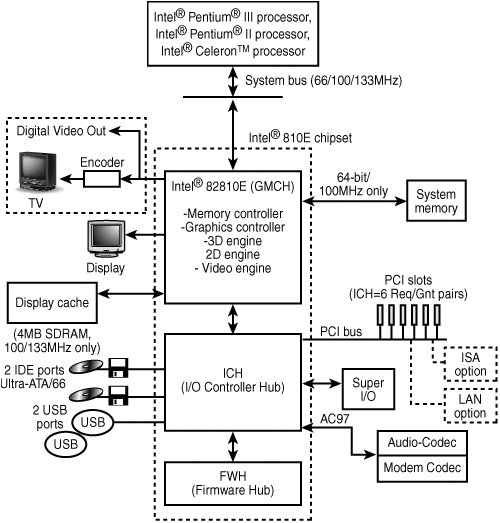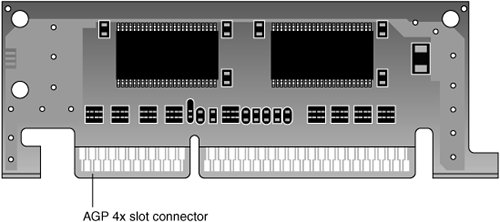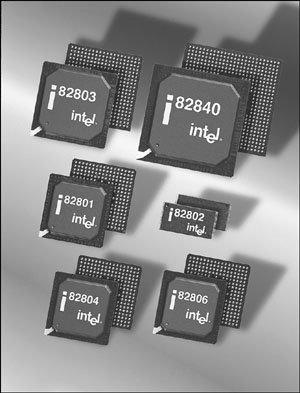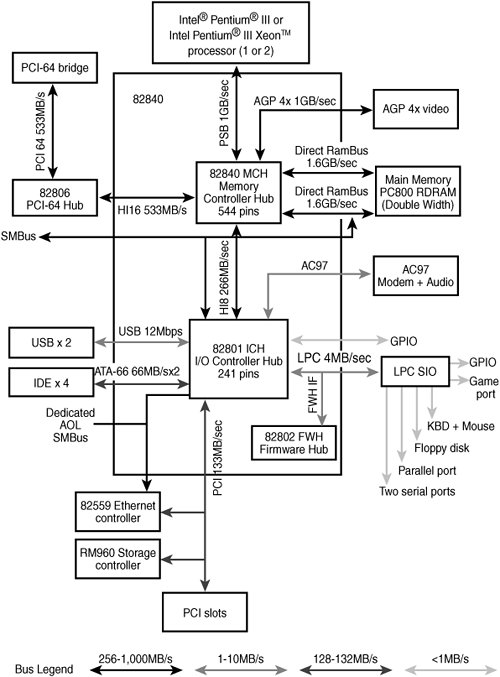Sixth-Generation (P6 Pentium ProIIIII Class) Chipsets
Sixth-Generation (P6 Pentium Pro/II/III Class) ChipsetsJust as Intel clearly dominated the Pentium chipset world, it is also the leading vendor for chipsets supporting its P6 processor families. As discussed earlier, the biggest reason for this is that, since the Pentium first came out in 1993, Intel has been introducing new chipsets (and even complete ready-to-go motherboards) simultaneously with its new processors. This makes it hard for anybody else to catch up. Another problem for other chipset manufacturers is that they are required to license the CPU bus interface design before they can produce a matching chipset. Note that because the Pentium Pro, Celeron, and Pentium II/III are essentially the same processor with different cache designs and minor internal revisions, the same chipset can be used for Socket 8 (Pentium Pro), Socket 370 (Celeron/Pentium III), and Slot 1 (Celeron/Pentium II/III) designs. Of course, the newer P6-class chipsets are optimized for the Socket 370 architecture and nobody is making any new designs for Socket 8 or Slot 1. Table 4.16 shows the chipsets used on Pentium Pro motherboards.
Note PCI 2.1 supports concurrent PCI operations. For the Celeron and Pentium II/III motherboards, Intel offers the chipsets in Table 4.17. 4xx series chipsets incorporate a North/South Bridge architecture, whereas 8xx series chipsets support the newer and faster hub architecture. P6/P7 (Pentium III/Celeron, Pentium 4, and Xeon) processor chipsets using hub architecture are shown in Table 4.18.
Note Pentium Pro, Celeron, and Pentium II/III CPUs have their secondary caches integrated into the CPU package. Therefore, cache characteristics for these machines are not dependent on the chipset but are quite dependent on the processor instead. Most Intel chipsets are designed as a two-part system, using a North Bridge (MCH or GMCH in hub-based designs) and a South Bridge (ICH in hub-based designs) component. Often the same South Bridge or ICH component can be used with several different North Bridge (MCH or GMCH) chipsets. Table 4.19 shows a list of all the Intel South Bridge components used with P6-class processors and their capabilities. The ICH2 is also used as part of some of the first seventh-generation (Pentium 4/Celeron 4) Intel chipsets.
The following sections examine the chipsets for P6 processors up through the Celeron and Pentium III, starting with the Intel 800 series chipsets. For a more detailed look at the 400 series, refer to the PDF version of Chapter 4 of Upgrading and Repairing PCs, 16th Edition, included on this book's DVD. Intel 810, 810E, and 810E2Introduced in April 1999, the Intel 810 chipset (code named Whitney) represents a major change in chipset design from the standard North and South Bridges that have been used since the 486 days. The 810 chipset allows for improvements in system performance, all for less cost and system complexity. The 810 (which supports 66MHz and 100MHz processor buses) was later revised as the 810E with support for the 133MHz processor bus. Note The 810E2 uses the same 82810E GMCH as the 810E but pairs it with the 82801BA I/O Controller Hub (ICH2) used by the Intel 815E. For information about the 82801BA ICH2 chip, see the section "Intel 815 Family," later in this chapter. The major features of the 810E chipset include
The 810E chipset consists of three major components:
Compared to the previous North/South Bridge designs, there are some fairly significant changes in the 810 chipset. The previous system designs had the North Bridge acting as the memory controller, talking to the South Bridge chip via the PCI bus. This new design has the GMCH taking the place of the North Bridge, which talks to the ICH via a 66MHz dedicated interface called the accelerated hub architecture (AHA) bus instead of the previously used PCI bus. In particular, implementing a direct connection between the North and South Bridges in this manner was key in implementing the new UDMA-66 high-speed IDE interface for hard disks, DVD drives, and other IDE devices. Figure 4.32 shows a system block diagram for the 810E chipset. With the 810 chipset family, ISA is finally dead. Figure 4.32. Intel 810E chipset system block diagram. The 82810E GMCH uses an internal Direct AGP (integrated AGP) interface to create 2D and 3D effects and images. The video capability integrated into the 82810E chip features hardware motion compensation to improve software DVD video quality; it also features both analog and direct digital video out ports, which enable connections to either traditional TVs (via an external converter module) or a direct digital flat panel display. The GMCH chip also incorporates the System Manageability Bus, which enables networking equipment to monitor the 810 chipset platform. Using ACPI specifications, the system manageability function enables low-power sleep mode and conserves energy when the system is idle. The 82801 I/O Controller Hub employs AHA for a direct connection from the GMCH chip. This is twice as fast (266MBps) as the previous North/South Bridge connections that used the PCI bus, and it uses far fewer pins for reduced electrical noise. Plus, the AHA bus is dedicated, meaning that no other devices will be on it. The AHA bus also incorporates optimized arbitration rules allowing more functions to run concurrently, enabling better video and audio performance. The ICH also integrates dual IDE controllers, which run up to either 33MBps (UDMA-33 or Ultra-ATA/33) or 66MBps (UDMA-66 or Ultra-ATA/66). Note that two versions of the ICH chip exist. The 82801AA (ICH) incorporates the 66MBps-capable ATA/IDE and supports up to six PCI slots, whereas the 82801AB (ICH0) supports only 33MBps ATA/IDE maximum and supports up to four PCI slots. The ICH also integrates an interface to an Audio-Codec 97 (AC'97) controller, dual USB ports, and the PCI bus with up to four or six slots. The Integrated Audio-Codec 97 controller enables software audio and modem by using the processor to run sound and modem software via very simple digital-to-analog conversion circuits. Reusing existing system resources lowers the system cost by eliminating components. The 82802 Firmware Hub (FWH) incorporates the system BIOS and video BIOS, eliminating a redundant nonvolatile memory component. The BIOS within the FWH is flash-type memory, so it can be field-updated at any time. In addition, the 82802 contains a hardware RNG. The RNG provides truly random numbers to enable fundamental security building blocks supporting stronger encryption, digital signing, and security protocols. Two versions of the FWH are available, called the 82802AB and 82802ACy. The AB version incorporates 512KB (4Mb) of Flash BIOS memory, and the AC version incorporates a full 1MB (8Mb) of BIOS ROM. With the Intel 810 and 810E chipsets, Intel did something that many in the industry were afraid of: It integrated the video and graphics controller directly into the motherboard chipset with no means of upgrade. This means systems using the 810 chipset don't have an AGP slot and aren't capable of using conventional AGP video cards. For the low-end market for which this chipset is designed, lacking an AGP slot shouldn't be too much of a drawback. Higher-end systems, on the other hand, use the 815 or other chipsets that do support AGP slots. Intel calls the integrated interface Direct AGP, and it describes the direct connection between the memory and processor controllers with the video controller all within the same chip. This means the video card as we know it will be reserved only for midrange and higher-end systems, as well as gaming-oriented systems. With the 810 as well as subsequent chipsets with integrated video, Intel has let it be known in a big way that it has entered the PC video business. In fact, the theme with the 810 chipset is one of integration. The integrated video means no video cards are required; the integrated AC'97 interface means that conventional modems and sound cards are not required. Plus, there is an integrated CMOS/Clock chip (in the ICH), and even the BIOS is integrated in the FWH chip.
Intel 815 FamilyIntroduced in June 2000, the 815 and 815E chipsets are mainstream PC chipsets with integral video that is also upgradeable via an AGP 4x slot. The E versions include the ICH2 I/O controller hub, which features two USB 1.1 controllers (four ports) and ATA-100 support. The 815P and EP versions were introduced later and lacked the integrated video for lower cost. In September 2001, the last members of the familythe 815G and 815EGwere introduced. Note that the G indicates that these chipsets also include integrated video, which was superior to the video included with the original 815 and 815E. The 815 chipsets are designed for Slot-1 or Socket-370 processors, such as the Celeron or Pentium III. These are the first chipsets from Intel designed to directly support PC133 SDRAM memory, allowing for a more affordable solution than other chipsets using RDRAM memory. Similar to the other 8xx series chipsets from Intel, the 815 uses hub architecture that provides a 266MBps connection between the main chipset components and does not share the PCI bus like the prior North/South Bridge designs. Although six variations on the 815 chipset are available, only five different parts are used to create the various members of the family: one memory controller hub (82815EP MCH: North Bridge replacement without integrated graphics), two graphics memory controller hubs (82815 or 82815G GMCH: North Bridge replacement with integrated graphics), and two I/O controller hubs (ICH and ICH2). Table 4.20 shows how these parts are combined to create the various members of the family.
All 815 chipsets support the following features:
The 815/E/G/EG also support the following:
The 815E/EP/EG uses the ICH2, which is most notable for providing ATA-100 support, allowing 100MBps drive performance. Of course, few drives can really take advantage of this much throughput, but in any case, there won't be a bottleneck there. The other notable feature is having two USB 1.1 controllers and four ports on board. This allows double the USB performance by splitting up devices over the two ports and can allow up to four connections before a hub is required. Integrated EthernetAnother important feature of the 815 series is the integration of a fast Ethernet controller directly into the chipset. The integrated LAN controller works with one of three new physical layer components from Intel and enables three distinct solutions for computer manufacturers. These include
These physical layer components can be placed directly on the PC motherboard (additional chips) or installed via an adapter that plugs into the CNR slot. The CNR slot and cards enable PC assemblers to build network-ready systems for several markets. AGP Inline Memory ModuleAlthough the 815/815E feature is essentially the same built-in AGP 2x 3D video that comes with the 810 chipset, the difference is upgradeability. The video can easily be upgraded by adding a graphics performance accelerator (GPA) card (see Figure 4.33) or an AGP 4x card for maximum 3D graphics and video performance. The GPA card (also called the AGP Inline Memory Module, or AIMM) is essentially a high-performance video memory card that works in the AGP 4x slot and improves the performance of the integrated video by up to 30%. Unfortunately, these are not commonly sold and are somewhat expensive. For even more performance, you can install a full 4x AGP card in the AGP 4x slot, which disables the integrated video. By having the video integrated, very low-cost systems with reasonable video performance can be assembled. By later installing either the GPA or a full 4x AGP card, you can improve video performance up to 100% or more. Figure 4.33. A typical 4MB GPA/AIMM module, which attaches to the AGP slot of a motherboard using the 815 or 815E chipset. PC133 Memory SupportAnother important feature of the 815 chipset is the support of PC133 memory. The 815 family also uses PC100 memory. With PC133 support, Intel has also officially set a standard for PC133 memory that was higher than some of the PC133 memory on the market at the time of introduction. To meet the Intel PC133 specification, the memory must support what is called 2-2-2 timing, sometimes also known as CAS-2 (column address strobe) or CL-2 timing. The numbers refer to the number of clock cycles for the following functions to complete:
Some of the PC133 memory on the market takes three cycles for each of these functions and would therefore be termed PC133 3-3-3, CAS-3, or CL-3 memory. Note that the faster PC133 CL-2 can be used in place of the slower CL-3 variety, but not the other way around. As a result of the tighter cycling timing, PC133 CL-2 offers a lead-off latency of only 30ns, instead of the 45ns required by PC133 CL-3. This results in a 34% improvement in initial access due to the decreased latency. The 815 chipset was a popular chipset for the mainstream PC market that didn't want to pay the higher prices for RDRAM memory. The 815 was essentially designed to replace the venerable 440BX chipset. Intel 820 and 820EThe Intel 820 chipsets use the hub-based architecture like all the 800 series chips and are designed to support slot 1 or socket 370 processors, such as the Pentium III and Celeron. The 820 chipset supports RDRAM memory technology, 133MHz system bus, and 4x AGP. The 82820 MCH provides the processor, memory, and AGP interfaces. Two versions are available: One supports a single processor (82820), whereas the other supports two processors (82820DP). Either is designed to work with the same 82801 ICH as used with the other 800 series chipsets, such as the 810 and 840. The 820 chipset also uses the 82802 FWH for BIOS storage and for the Intel RNG. The connection between the MCH and ICH uses what is called the Intel Hub Architecture bus instead of the PCI bus as with prior North/South Bridge chipsets. The hub architecture bus provides twice the bandwidth of PCI at 266MB per second, enabling twice as much data to flow between them. The hub architecture bus also has optimized arbitration rules, allowing more functions to run concurrently, as well as far fewer signal pins, reducing the likelihood of encountering or generating noise and signal errors. The 820 chipset is designed to use RDRAM memory, which has a maximum throughput of up to 1.6GBps. The 820 supports PC600, PC700, and PC800 RDRAM, delivering up to 1.6GBps of theoretical memory bandwidth in the PC800 version. PC800 RDRAM is a 400MHz bus running double-clocked and transferring 16 bits (2 bytes) at a time (2x400MHzx2 bytes = 1.6GBps). Two RIMM sockets are available to support up to 1GB of total system memory. The AGP interface in the 820 enables graphics controllers to access main memory at AGP 4x speed, which is about 1GB per secondtwice that of previous AGP 2x platforms. Figure 4.34 shows the 820 chipset architecture. Because the 820 was designed for midrange to higher-end systems, it does not include integrated graphics, relying instead on the AGP 4x slot to contain a graphics card. Figure 4.34. Intel 820 chipset architecture.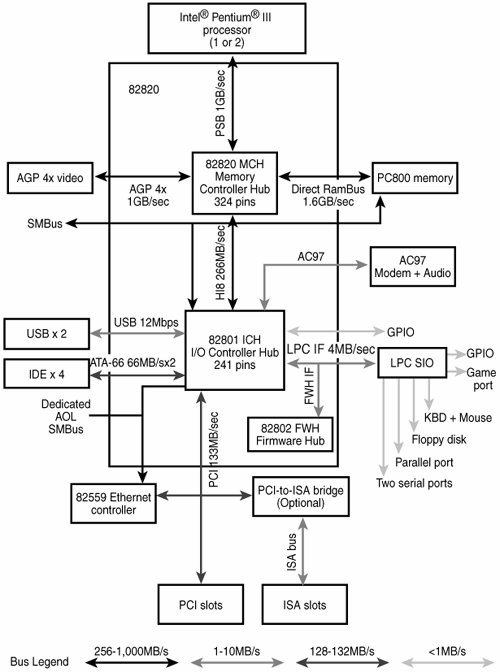 820 Chipset features include
The 820 chipset consists of three main components with a few optional extras. The main component is the 82820 (single-processor) or 82820DP (dual-processor) MCH, which is a 324 BGA chip. That is paired with an 82801 ICH, which is a 241 BGA chip, and finally it has the 82802 FWH, which is really just a fancy Flash ROM BIOS chip. Optionally, there can be an 82380AB PCI-ISA bridge that is used only if the board is equipped with ISA slots. The newer 820E version uses an updated 82801BA ICH2, which supports ATA-100 and incorporates dual USB 1.1 controllers with two ports each, for a total of four USB 1.1 ports. 820. Chipset MTH BugThe 820 chipset is designed to support RDRAM memory directly. However, because the market still demanded lower-cost SDRAM, Intel created an RDRAM-to-SDRAM translator chip called the Memory Translator Hub (MTH). This enabled them to produce 820 chipset motherboards that supported SDRAM instead of the more expensive RDRAM. Because the design of the MTH was proven defective, the chip (and any board using it) was simply discontinued. On May 10, 2000, Intel officially announced that it would replace any motherboards using the MTH with a new board lacking the component. The MTH translates signals from SDRAM memory to the Intel 820 chipset and is used only with motherboards utilizing SDRAM and the Intel 820 chipset; boards using RDRAM don't have an MTH and were not affected. Intel found electrical noise issues with the MTH that can cause some systems to intermittently reset, reboot, or hang. In addition, the noise issue can, under extreme conditions, potentially cause data corruption. The MTH bug forced Intel to recall and replace more than a million motherboards in mid-2000, with new versions lacking the MTH and thus supporting only RDRAM memory. The final bill for this recall was reported at about $253 million, making it perhaps the most costly recall of computer components since the infamous Pentium math bug in 1994. I found it interesting that, due to the fact that Intel did more than $24.4 billion in sales the previous year, at least one article classified the cost of this recall as "chump change" to the chip giant! At one time, Intel offered an MTH I.D. utility that told you whether you had that component and whether your board was eligible for replacement, including a 128MB RDRAM RIMM. However, Intel is no longer supporting this chipset, and the utility is not available. Again, note that the 820 chipset was really designed to support RDRAM as the native type of memory, and RDRAM-based systems are not affected because they don't use the memory translator hub component. Intel 840The Intel 840 is a high-end chipset designed for use in high-performance multiprocessor systems using Slot 1, Slot 2 (Xeon processor), or Socket 370 processors. The 840 chipset uses the same hub architecture and modular design as the rest of the 800 family chipsets, with some additional components enabling more performance. See Figure 4.35 for a photo of the Intel 840 chipset. Figure 4.35. Intel 840 chipset showing the 82840 (MCH), 82801 (ICH), 82802 (FWH), 82803 (MRH-R), 82804 (MRH-S), and 82806 (P64H) chips. Photograph used by permission of Intel Corporation. As with the other 800 series chipsets, the 840 has three main components:
In addition to the core components, parts are available for scaling up to a more powerful design. Three additional components can be added:
Figure 4.36 shows the 840 chipset architecture. Figure 4.36. Intel 840 chipset architecture. 840 chipset features include
Optionally, network interface and RAID controller interface chips can be added as well. Third-Party (Non-Intel) P6-Class ChipsetsSeveral companies produce chipsets designed to support P6-class processors, including ALi Corporation (formerly known as Acer Laboratories), VIA Technologies, and SiS. The following sections discuss the offerings from these companies. ULi (Acer Labs) Chipsets for P6-Class ProcessorsULi Electronics' predecessor, Acer Labs, manufactured a variety of chipsets for the P6-class processors. Table 4.21 provides an overview of these chipsets.
Table 4.22 provides an overview of the features of the South Bridge chips used in these chipsets. ULi Electronics, Inc., successor to Acer Labs, continues to manufacture some of these chips.
For more information about these chipsets, see Upgrading and Repairing PCs, 14th Edition, found in electronic form on the disc packaged with this book. VIA Technologies Chipsets for P6-Class ProcessorsVIA Technologies has a variety of chipsets for the P6 processors. They are discussed in the following sections and Table 4.23.
Silicon Integrated Systems Chipsets for P6-Class ProcessorsSilicon Integrated Systems has a variety of chipsets for the P6-class processors. They are discussed in the following sections, and Table 4.25 provides a summary of them.
Table 4.24 provides an overview of the features of the South Bridge chips used in these chipsets | |||||||||||||||||||||||||||||||||||||||||||||||||||||||||||||||||||||||||||||||||||||||||||||||||||||||||||||||||||||||||||||||||||||||||||||||||||||||||||||||||||||||||||||||||||||||||||||||||||||||||||||||||||||||||||||||||||||||||||||||||||||||||||||||||||||||||||||||||||||||||||||||||||||||||||||||||||||||||||||||||||||||||||||||||||||||||||||||||||||||||||||||||||||||||||||||||||||||||||||||||||||||||||||||||||||||||||||||||||||||||||||||||||||||||||||||||||||||||||||||||||||||||||||||||||||||||||||||||||||||||||||||||||||||||||||||||||||||||||||||||||||||||||||||||||||||||||||||||||||||||||||||||||||||||||||||||||||||||||||||||||||||||||||||||||||||||||||||||||||||||||||||||||||||||||||||||||||||||||||||||||||||||||||||||||||||||||||||||||||||||||||||||||||||||||||||||||||||||||||||||||||||||||||||||||||||||||||||||||||||||||||||||||||||||||||||||||||||||||||||||||||||||||||||||||||||||||||||||||||||||||||||||||||||||||||||||||||||||||||||||||||||||||||||||||||||||||||||||||||||
EAN: 2147483647
Pages: 283
